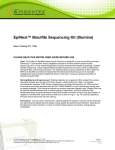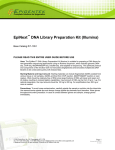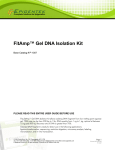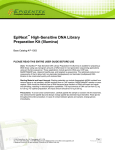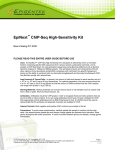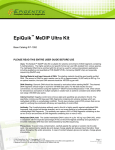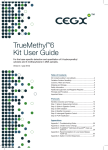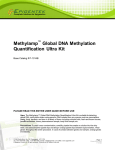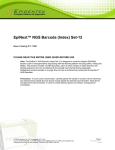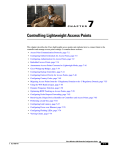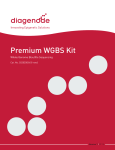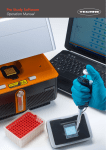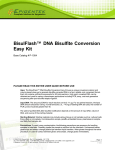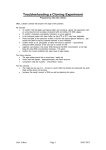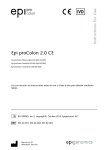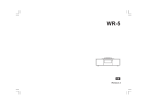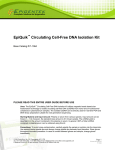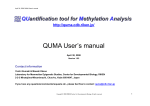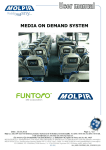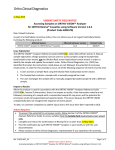Download EpiNext™ Post-Bisulfite DNA Library Preparation Kit (Illumina)
Transcript
EPIGENTEK Complete Solutions for Epigenetics EpiNext™ Post-Bisulfite DNA Library Preparation Kit (Illumina) Base Catalog # P-1055 PLEASE READ THIS ENTIRE USER GUIDE BEFORE USE Uses: The EpiNext™ Post-Bisulfite DNA Library Preparation Kit (Illumina) is suitable for preparing a DNA library for various Illumina platform-based bisulfite sequencing (bisulfite-seq) assays such as whole genome bisulfite sequencing (WGBS), oxidative bisulfite sequencing (oxBs-seq), reduced representative bisulfite sequencing (RRBS), and other bisulfite-next generation sequencing applications. The optimized protocol and components of the kit allow both non-barcoded (singleplexed) and barcoded (multiplexed) DNA libraries to be quickly constructed using sub-nanogram input concentrations of DNA since the DNA is first bisulfite-converted and then used for library preparation. Starting Material and Input amount: Starting material is bisulfite-treated DNA that is generated from various input DNA amounts ranging from 0.5 ng to 1 µg. For optimal preparation, the input DNA amount for bisulfite conversion should be 100 ng to 200 ng so that sufficient bisulfite-treated DNA can be yielded. Precautions: To avoid cross-contamination, carefully pipette the sample or solution into the tubes/vials. Use aerosol-barrier pipette tips and always change pipette tips between liquid transfers. Wear gloves throughout the entire procedure. In case of contact between gloves and sample, change gloves immediately. 110 Bi County Blvd. Ste. 122, Farmingdale, NY 11735 Tel: 1-877-374-4368 ■ Fax: 1-718-484-3956 ■ E-mail: [email protected] ■ Web: www.epigentek.com © Epigentek Group Inc. All rights reserved. Products are for research use only. Page 1 Printed 2013-12-31 P-1055 EPIGENTEK Complete Solutions for Epigenetics KIT CONTENTS Component 12 reactions Cat. #P-1055-12 24 reactions Cat. #P-1055-24 Storage Upon Receipt 5X Conversion Buffer* Conversion Enzyme Mix* Conversion Primer* 10X End Repair Buffer* End Repair Enzyme Mix* 10X dA-Tailing Buffer* Klenow Fragment (3’-5’ exo-)* 2X Ligation Buffer* T4 DNA Ligase* Adaptors (50 µM)* MQ Binding Beads* 2X HiFi PCR Master Mix* Primer U (10 µM)* Primer I (10 µM)* Elution Buffer User Guide 50 µl 15 µl 26 µl 40 µl 25 µl 40 µl 15 µl 250 µl 15 µl 15 µl 1.8 ml 160 µl 15 µl 15 µl 1000 µl 1 100 µl 30 µl 52 µl 80 µl 50 µl 80 µl 30 µl 500 µl 30 µl 30 µl 3.6 ml 320 µl 30 µl 30 µl 2000 µl 1 -20°C -20°C -20°C -20°C -20°C -20°C -20°C -20°C -20°C -20°C 4°C -20°C -20°C -20°C -20°C RT * Spin the solution down to the bottom prior to use. SHIPPING & STORAGE The kit is shipped on frozen ice packs at 4°C. Upon receipt, store the following components at -20°C immediately: 5X Conversion Buffer, Conversion Enzyme Mix, Conversion Primer, 10X End Repair Buffer, End Repair Enzyme Mix,10X dA-Tailing Buffer, Klenow Fragment (3’-5’ exo-), 2X Ligation Buffer, T4 DNA Ligase, Adaptors, 2X HiFi PCR Master Mix, Primer U, Primer I, and Elution Buffer. Store the following components at 4°C: MQ Binding Beads. Store all other components at room temperature. MATERIALS REQUIRED BUT NOT SUPPLIED Vortex mixer Agilent® Bioanalyzer® or comparable method to assess the quality of DNA library Thermocycler Centrifuge including desktop centrifuge (up to 14,000 rpm) Magnetic stand (96-well PCR plate format) Pipettes and pipette tips 110 Bi County Blvd. Ste. 122, Farmingdale, NY 11735 Tel: 1-877-374-4368 ■ Fax: 1-718-484-3956 ■ E-mail: [email protected] ■ Web: www.epigentek.com © Epigentek Group Inc. All rights reserved. Products are for research use only. Page 2 Printed 2013-12-31 P-1055 EPIGENTEK Complete Solutions for Epigenetics PCR tubes or plates 1.5 ml microcentrifuge tubes 100% ethanol Distilled water Bisulfite-treated DNA sample GENERAL PRODUCT INFORMATION Quality Control: Each lot of EpiNext™ Post-Bisulfite DNA Library Preparation Kit (Illumina) is tested against predetermined specifications to ensure consistent product quality. Epigentek guarantees the performance of all products in the manner described in our product instructions. Product Warranty: If this product does not meet your expectations, simply contact our technical support unit or your regional distributor. We also encourage you to contact us if you have any suggestions about product performance or new applications and techniques. Safety: Suitable lab coat, disposable gloves, and proper eye protection are required when working with this product. Product Updates: Epigentek reserves the right to change or modify any product to enhance its performance and design. The information in this User Guide is subject to change at any time without notice. Thus, only use the User Guide that was supplied with the kit when using that kit. Usage Limitation: The EpiNext™ Post-Bisulfite DNA Library Preparation Kit (Illumina) is for research use only and is not intended for diagnostic or therapeutic application . Intellectual Property: The EpiNext™ Post-Bisulfite DNA Library Preparation Kit (Illumina) and methods of use contain proprietary technologies by Epigentek. A BRIEF OVERVIEW DNA methylation occurs by the covalent addition of a methyl group (CH3) at the 5-carbon of the cytosine ring, resulting in 5-methylcytosine (5-mC). DNA methylation is essential in regulating gene expression in nearly all biological processes including development, growth, and differentiation. Alterations in DNA methylation have been demonstrated to cause a change in gene expression. For example, hypermethylation leads to gene silencing or decreased gene expression while hypomethylation activates genes or increases gene expression. Aberrant DNA methylation is also associated with pathogenesis of diseases such as cancer, autoimmune disorders, and schizophrenia. Thus genome-wide analysis of DNA methylation could provide valuable information for discovering epigenetic markers used for disease diagnosis and potential therapeutic targets. Several methods such as whole genome bisulfite sequencing (WGBS) or reduced representation bisulfite sequencing (RRBS) are currently used for genome-wide DNA methylation analysis. These methods convert unmethylated cytosine to uracil while 5-mC remains unmodified by the bisulfite treatment. This allows epigenetic differences to be interpreted as genetic differences, which can then be detected by sequencing at single-base resolution and on a genome-wide scale. However, traditional methods to achieve this still do not have practical use because (1) such methods require large amounts of DNA (>1 µg) as input material, which is difficult to prepare from limited biological samples such as tumor biopsy samples, early embryos, embryonic tissues and circulating DNA; (2) such methods require that DNA is first sheared and then ligated to adaptors 110 Bi County Blvd. Ste. 122, Farmingdale, NY 11735 Tel: 1-877-374-4368 ■ Fax: 1-718-484-3956 ■ E-mail: [email protected] ■ Web: www.epigentek.com © Epigentek Group Inc. All rights reserved. Products are for research use only. Page 3 Printed 2013-12-31 P-1055 EPIGENTEK Complete Solutions for Epigenetics followed by bisulfite conversion (post-ligation bisulfite conversion). This procedure causes most of the DNA fragments contained in the adaptor-DNA fragment constructs to be broken, and thereby form mono-tagged templates that will be removed during library enrichment. Thus, incomplete coverage and bias occur when performing whole genome bisulfite sequencing; and (3) such methods are time-consuming (2 days). To overcome the weaknesses of these methods, Epigentek offers the EpiNext™ Post-Bisulfite DNA Library Preparation Kit (Illumina). The kit has the following features: Allows bisulfite-converted DNA to be used directly for ligation, thereby eliminating the possibility of breaking adapter-ligated fragments, which can often occur in currently used WGBS and RRBS methods. Fast 5-hour procedure, from input starting material to library amplification. Gel-free size selection/purification saves time and prevents handling errors, as well as loss of valuable samples. High sensitivity, efficiency and flexibility-- direct ligation of adapter to bisulfite-converted DNA fragments reduces loss of fragments and selection bias, which enables pre-bisulfite input DNA to be as low as 1 ng. The kit can be used for both non-barcoded (singleplexed) and barcoded (multiplexed) DNA library preparation. Comprehensive set of components to accommodate each step of DNA library preparation -- ligation, clean-up, size selection, and library amplification -- for convenience, consistency, and reliability. Ultra HiFi amplification enables achievement of reproducibly high yields of DNA libraries with minimal sequence bias and low error rates. PRINCIPLE & PROCEDURE With this kit, bisulfite-treated DNA (which is in single-stranded form), is converted to double-stranded DNA and directly used for ligation with BisDNA-specific adapters which are necessary for amplification and sequencing. The fragments are then size selected and purified with MQ beads, which allows for quick and precise size selections of DNA. Size-selected DNA fragments are then amplified with a highfidelity PCR Mix, ensuring maximum yields from minimum amounts of starting material and providing a highly accurate amplification of library DNA with low error rates and minimal bias. 110 Bi County Blvd. Ste. 122, Farmingdale, NY 11735 Tel: 1-877-374-4368 ■ Fax: 1-718-484-3956 ■ E-mail: [email protected] ■ Web: www.epigentek.com © Epigentek Group Inc. All rights reserved. Products are for research use only. Page 4 Printed 2013-12-31 P-1055 EPIGENTEK Complete Solutions for Epigenetics Bisulfite DNA dsDNA Conversion End Repair dA Tailing A 5’ 3’ A 3’ 5’ Adaptor Ligation Size Selection Amplification Next Generation Sequencing Fig 2. Size distribution of library fragments as demonstrated by a post-bisulfite DNA library constructed using the EpiNext™ Post-Bisulfite DNA Library Preparation Kit from 10 ng of input DNA. Fig 1. Workflow of the EpiNext™ Post-Bisulfite DNA Library Preparation Kit (Illumina) ASSAY PROTOCOL For the best results, please read the protocol in its entirety prior to starting your experiment. Starting Materials Amount of Input DNA used for bisulfite treatment: Input amount of pre-bisulfite DNA can range from 500 pg to 1 μg per reaction, which could yield bisulfite-treated DNA ranging from at least 50 pg to 200 ng. An optimal pre-bisulfite DNA amount is 100 ng to 200 ng per reaction. Input DNA should be of high quality and relatively free of RNA. RNAse I can be used to remove RNA. Bisulfite-treated DNA: Bisulfite DNA can be generated with home-brew bisulfite conversion protocols or commercially available kits. However most of these protocols/kits cannot generate fragments of appropriate length for library preparation use. The peak size of bisulfite-treated DNA fragments should be 200-400 bps in length. For ideal compatibility, we highly recommend using Epigentek’s BisulFlash™ DNA Modification Kit (Cat. No. P-1026) and its Alternative Enhanced Program protocol in its user manual for DNA bisulfite treatment. This kit is demonstrated to fragment DNA to about 250 bps at peak size. Epigentek’s MethylampTM DNA modification kit (Cat. No. P-1001) is also suitable for generating appropriate fragments that can be directly used in post-bisulfite DNA library preparation. 110 Bi County Blvd. Ste. 122, Farmingdale, NY 11735 Tel: 1-877-374-4368 ■ Fax: 1-718-484-3956 ■ E-mail: [email protected] ■ Web: www.epigentek.com © Epigentek Group Inc. All rights reserved. Products are for research use only. Page 5 Printed 2013-12-31 P-1055 EPIGENTEK Complete Solutions for Epigenetics Validation of bisulfite DNA quality: To ensure that the bisulfite-treated DNA is suitable for direct ligation, we recommend checking the bisulfite-treated DNA by real time methylation-specific PCR (MSP). For your convenience and the best results, Epigentek provides the Methylamp™ MS-qPCR Fast Kit (Cat. No. P-1028) for real time MSP. Both positive primers (b-actin, component of kit Cat. No. P-1028) and negative primers (GAPDH, component of kit Cat. No. P-1029) are also separately available to verify conversion efficiency. 1. dsDNA Conversion Reaction a. Prepare dsDNA Conversion reaction in a 0.2 ml PCR tube according to Table 1: Table 1. dsDNA Conversion Component Volume Bisulfite DNA* 10 µl (100-200 ng input DNA) 5X Conversion Buffer Conversion Primer Distilled Water Total Volume 4 µl 2 µl 3 µl 19 µl * Note: The optimal amount of input DNA should be 100 ng to 200 ng and eluted volume after bisulfite treatment should be < 20 µl. b. c. Mix and incubate for 5 min at 95°C in a thermocycler (without heated lid) followed by 5 min at 4°C or on ice. Add 1 µl of Conversion Enzyme Mix to the reaction tube. Mix and incubate for 60 min at 37 °C in a thermocycler (without heated lid). 2. Clean Up of Converted dsDNA a. b. c. d. e. f. g. h. i. j. Resuspend MQ Binding Beads by vortex. Add 36 μl of resuspended beads to the PCR tube of dsDNA conversion reaction. Mix thoroughly on a vortex mixer or by pipetting up and down at least 10 times. Incubate for 10 minutes at room temperature to allow DNA to bind to the beads. Put the PCR tube on an appropriate magnetic stand until the solution is clear (about 2 minutes). Carefully remove and discard the supernatant. Be careful not to disturb or discard the beads that contain DNA. Keep the PCR tube in the magnetic stand and add 200 μl of freshly prepared 80% ethanol to the tube. Incubate at room temperature for 1 min, and then carefully remove and discard the ethanol. Repeat Step 2e one time for a total of two washes. Open the cap of the PCR tube and air dry beads for 10 minutes while the tube is on the magnetic stand. Resuspend the beads in 12 µl Elution Buffer, and incubate at room temperature for 2 minutes to release the DNA from the beads. Capture the beads by placing the tube in the magnetic stand for 2 minutes or until the solution is completely clear. Transfer the clear solution to a new 0.2 ml PCR tube for the end repair reaction. 110 Bi County Blvd. Ste. 122, Farmingdale, NY 11735 Tel: 1-877-374-4368 ■ Fax: 1-718-484-3956 ■ E-mail: [email protected] ■ Web: www.epigentek.com © Epigentek Group Inc. All rights reserved. Products are for research use only. Page 6 Printed 2013-12-31 P-1055 EPIGENTEK Complete Solutions for Epigenetics 3. DNA End Repairing a. Prepare end repair reaction in a 0.2 ml PCR tube according to Table 2: Table 2. End Repair Reaction b. Component Volume Converted dsDNA (from Step 2) 11-12 µl 10X End Repair Buffer End Repair Enzyme Mix Distilled Water Total Volume 2 µl 1 µl 5-6 µl 20 µl Mix and incubate for 30 min at 20°C in a thermal cycler. 4. Clean-Up of End Repaired DNA a. b. c. d. e. h. i. h. i. j. Resuspend MQ Binding Beads by vortex. Add 36 μl of resuspended beads to the PCR tube of end repair reaction. Mix thoroughly on a vortex mixer or by pipetting up and down at least 10 times. Incubate for 10 minutes at room temperature to allow DNA to bind to the beads. Put the PCR tube on an appropriate magnetic stand until the solution is clear (about 2 minutes). Carefully remove and discard the supernatant. Be careful not to disturb or discard the beads that contain DNA. Keep the PCR tube in the magnetic stand and add 200 μl of freshly prepared 80% ethanol to the tube. Incubate at room temperature for 1 min, and then carefully remove and discard the ethanol. Repeat Step 4e one time for a total of two washes. Open the cap of the PCR tube and air dry beads for 10 minutes while the tube is on the magnetic stand. Resuspend the beads in 12 µl Elution Buffer, and incubate at room temperature for 2 minutes to release the DNA from the beads. Capture the beads by placing the tube in the magnetic stand for 2 minutes or until the solution is completely clear. Transfer the clear solution to a new 0.2 ml PCR tube for the dA tailing reaction. 5. DNA dA-Tailing a. Prepare the reaction mix for dA-tailing according to Table 3. Add the following reagents to a 0.2 ml PCR tube containing end repaired DNA from Step 4. Table 3. dA-Tailing Reaction Component Volume End repaired DNA (from Step 4) 12 µl 10X dA-tailing Buffer 1.5 µl 1 µl 0.5 µl 15 µl Klenow Fragment (3’-5’ exo-) Distilled Water Total Volume 110 Bi County Blvd. Ste. 122, Farmingdale, NY 11735 Tel: 1-877-374-4368 ■ Fax: 1-718-484-3956 ■ E-mail: [email protected] ■ Web: www.epigentek.com © Epigentek Group Inc. All rights reserved. Products are for research use only. Page 7 Printed 2013-12-31 P-1055 EPIGENTEK Complete Solutions for Epigenetics b. Mix and incubate for 30 min at 37°C followed by 10 min at 75°C in a thermocycler. 6. Adaptor Ligation a. Prepare a reaction mix for adaptor ligation according to Table 4. Add the following reagents to a 0.2 ml PCR tube containing end repaired/dA tailing DNA from Step 5. Table 4. Adaptor Ligation Component Volume End repaired/dA-tailing DNA (from Step 5) 15 µl 2X Ligation Buffer 17 µl 1 µl 1 µl 34 µl T4 DNA Ligase Adaptors Total Volume b. Mix and incubate for 10 min at 25°C in a thermocycler (without heated lid). Note: (1) The pre-annealed adapters included in the kit are suitable for both non-barcoded (singleplexed) and barcoded (multiplexed) DNA library preparation and are fully compatible with Illumina platforms, such as MiSeq® or HiSeq™ sequencers. (2) If using adaptors from other suppliers (both single-end and barcode adaptors), make sure they are compatible with Illumina platforms and add the correct amount (final concentration 1.5-2 µM, or according to the supplier’s instruction). 7. Size Selection/Clean-Up 7.1. Size Selection of Ligated DNA (Optional) Note: If the starting DNA amount is less than 200 ng, size selection is not recommended and alternatively, clean-up of ligated DNA can be performed prior to PCR amplification according to 7.2. protocol – “Clean-Up of Ligated DNA”. a. b. c. d. e. f. g. h. i. Resuspend MQ Binding Beads by vortex. Add 14 µl of resuspended MQ Binding Beads to the tube of ligation reaction. Mix well by pipetting up and down at least 10 times. Incubate for 5 minutes at room temperature. Put the tube on an appropriate magnetic stand until the solution is clear (about 2 minutes). Carefully transfer the supernatant containing DNA to a new tube (Caution: Do not discard the supernatant). Discard the beads that contain the unwanted large fragments. Add 10 µl of re-suspended beads to the supernatant, mix well and incubate for 5 minutes at room temperature. Put the PCR tube on an appropriate magnetic stand until the solution is clear (about 2 minutes). Carefully remove and discard the supernatant. Be careful not to disturb or discard the beads that contain DNA. Keep the PCR tube in the magnetic stand and add 200 μl of freshly prepared 80% ethanol to the tube. Incubate at room temperature for 1 min, and then carefully remove and discard the ethanol. Repeat Step 7.1g one time, for a total of two washes. Open the PCR tube cap and air dry beads for 10 minutes while the tube is on the magnetic stand. 110 Bi County Blvd. Ste. 122, Farmingdale, NY 11735 Tel: 1-877-374-4368 ■ Fax: 1-718-484-3956 ■ E-mail: [email protected] ■ Web: www.epigentek.com © Epigentek Group Inc. All rights reserved. Products are for research use only. Page 8 Printed 2013-12-31 P-1055 EPIGENTEK Complete Solutions for Epigenetics j. k. l. Resuspend the beads in 12 µl Elution Buffer, and incubate at room temperature for 2 minutes to release the DNA from the beads. Capture the beads by placing the tube in the magnetic stand for 2 minutes or until the solution is completely clear. Transfer clear solution to a new 0.2 ml PCR tube for PCR amplification. 7.2. Clean-Up of Ligated DNA a. b. c. d. e. f. g. h. i. j. Resuspend MQ Binding Beads by vortex. Add 34 μl of resuspended beads to the PCR tube of ligation reaction. Mix thoroughly on a vortex mixer or by pipetting up and down at least 10 times. Incubate for 5 minutes at room temperature to allow DNA to bind to beads. Put the PCR tube on an appropriate magnetic stand until the solution is clear (about 2 minutes). Carefully remove and discard the supernatant. Be careful not to disturb or discard the beads that contain DNA. Keep the PCR tube in the magnetic stand and add 200 μl of freshly prepared 80% ethanol to the tube. Incubate at room temperature for 1 min, and then carefully remove and discard the ethanol. Repeat Step 7.2e two times for a total of three washes. Open the PCR tube cap and air dry beads for 10 minutes while the tube is on the magnetic stand. Resuspend the beads in 12 µl Elution Buffer, and incubate at room temperature for 2 minutes to release the DNA from the beads. Capture the beads by placing the tube in the magnetic stand for 2 minutes or until the solution is completely clear. Transfer 11 µl of clear solution to a new 0.2 ml PCR tube for PCR amplification. 8. Library Amplification a. Prepare the PCR Reactions: Thaw all reaction components including master mix, DNA/RNA free water, primer solution and DNA template. Mix well by vortexing briefly. Keep components on ice while in use, and return to –20˚C immediately following use. Add components into each PCR tube/well according to the following table: Component Size (:l) Final Concentration Component Size (µl) HiFi Master Mix (2X) 12.5 µl Primer U 1 µl Primer I 1 µl Adaptor Ligated DNA 10.5 µl Total Volume 25 µl Important Note: Use of Primer I included in the kit will generate a singleplexed library. For multiplexed library preparation, replace Primer I with one of the12 different barcodes (indexes) contained in the EpiNextTM NGS Barcode (Index) Set-12 (Cat. No. P-1060). You can also add userdefined barcodes (Illumina compatible) instead of Primer I. b. Program the PCR Reactions: 110 Bi County Blvd. Ste. 122, Farmingdale, NY 11735 Tel: 1-877-374-4368 ■ Fax: 1-718-484-3956 ■ E-mail: [email protected] ■ Web: www.epigentek.com © Epigentek Group Inc. All rights reserved. Products are for research use only. Page 9 Printed 2013-12-31 P-1055 EPIGENTEK Complete Solutions for Epigenetics Place the reaction plate in the PCR instrument and set the PCR conditions as follows: Cycle Step Temp Time Cycle Activation 98°C 30 sec 1 Cycling 98°C 55°C 72°C 20 sec 20 sec 20 sec Variable* Final Extension 72°C 2 min 1 * Note: PCR cycles may vary depending on the input DNA amount. In general, use 12 PCR cycles for 200 ng, 13 cycles for 100 ng, 15 cycles for 50 ng, 17 cycles for 10 ng, and 22 cycles for 1 ng DNA input. Further optimization of PCR cycle number may be required by the end user. 9. Clean-Up of Amplified Library DNA a. b. c. d. e. f. g. h. i. j. Resuspend MQ Binding Beads by vortex. Add 25 μl of resuspended beads to the PCR tube of amplification reaction. Mix thoroughly on a vortex mixer or by pipetting up and down at least 10 times. Incubate for 5 minutes at room temperature to allow DNA to bind to the beads. Put the PCR tube on an appropriate magnetic stand until the solution is clear (about 2 minutes). Carefully remove and discard the supernatant. Be careful not to disturb or discard the beads that contain DNA. Keep the PCR tube in the magnetic stand and add 200 μl of freshly prepared 80% ethanol to the tube. Incubate at room temperature for 1 min, and then carefully remove and discard the ethanol. Repeat Step 9e two times for total of three washes. Open the PCR tube cap and air dry beads for 10 minutes while the tube is on the magnetic stand. Resuspend the beads in 12 µl Elution Buffer, and incubate at room temperature for 2 minutes to release the DNA from the beads. Capture the beads by placing the tube in the magnetic stand for 2 minutes or until the solution is completely clear. Transfer 12 µl of clear solution to a new 0.2 ml PCR tube. Quality of the prepared library can be assessed using an Agilent® Bioanalyzer® or other comparable methods. Library fragments should have the correct size distribution (e.g., 300 bps at peak size) without adaptors or adaptor-dimers. To check the size distribution, dilute library 2-fold with water and apply it to an Agilent® high sensitivity chip. If there is presence of <150 bp adaptor dimers or of larger fragments than expected, they should be removed. To remove fragments below 150 bps use 1X MQ Binding Beads (e.g., dilute amplified library DNA to 20 µl with TE and then add 20 µl of MQ Binding Beads) according to sub-steps a through i of Step 9 – “Clean-up of Amplified Library DNA”. To remove fragments above 500 bps, follow sub-steps a through j of Step 7.1 – “Size Selection of Ligated DNA”. The prepared DNA library can be quantified using various DNA library quantification methods. The prepared DNA library can be stored at -20˚C until ready to use for sequencing. 110 Bi County Blvd. Ste. 122, Farmingdale, NY 11735 Tel: 1-877-374-4368 ■ Fax: 1-718-484-3956 ■ E-mail: [email protected] ■ Web: www.epigentek.com © Epigentek Group Inc. All rights reserved. Products are for research use only. Page 10 Printed 2013-12-31 P-1055 EPIGENTEK Complete Solutions for Epigenetics TROUBLESHOOTING Problem Possible Cause Suggestion Low yield of library Insufficient amount of bisulfite DNA. To obtain the best results, the amount of input DNA for bisulfite treatment should be 100-200 ng. Insufficient purity of bisulfite DNA. Check if the sample DNA 260/280 ratio is between 1.8-1.9 and if DNA is degraded by running a gel. Ensure that RNA is removed by Rnase treatment. Inproper reaction conditions at each reaction step. Check if the reagents are properly added and incubation temperature and time are correct at each reaction step including Adaptor Ligation, Size Selection and Amplification. Improper storage of the kit. Ensure that the kit has not exceeded the expiration date. Standard shelf life, when properly stored, is 6 months from date of receipt. Improper ratio of MQ Binding Beads to DNA volume during size selection. Check if the correct volume of MQ Binding Beads was added to the DNA solution accordingly. Proper ratios should remove fragments of unexpected peak size. Insufficient ligation. Too much and too little input DNA may cause insufficient ligation, which can shift the peak size of the fragment population to be shorter or larger than expected. Make sure that the ligation reaction is properly processed using the proper amount of input DNA. Over-amplification of library. PCR artifacts from over-amplification of the library may cause the fragment population to shift higher than expected. Make sure to use proper PCR cycles to avoid this problem. Unexpected peak size of Agilent® Bioanalyzer® trace: Presence of <150 bp adaptor dimers or presence of larger fragments than expected RELATED PRODUCTS DNA Isolation and Cleanup P-1003 FitAmp™ General Tissue Section DNA Isolation Kit P-1004 FitAmp™ Plasma/Serum DNA Isolation Kit P-1006 DNA Concentrator Kit P-1007 FitAmp™ Gel DNA Isolation Kit P-1009 FitAmp™ Paraffin Tissue Section DNA Isolation Kit P-1017 FitAmp™ Urine DNA Isolation Kit P-1018 FitAmp™ Blood and Cultured Cell DNA Extraction Kit 110 Bi County Blvd. Ste. 122, Farmingdale, NY 11735 Tel: 1-877-374-4368 ■ Fax: 1-718-484-3956 ■ E-mail: [email protected] ■ Web: www.epigentek.com © Epigentek Group Inc. All rights reserved. Products are for research use only. Page 11 Printed 2013-12-31 P-1055 EPIGENTEK Complete Solutions for Epigenetics DNA Bisulfite Conversion P-1001 Methylamp™ DNA Modification KIt P-1026 BisulFlash™ DNA Modification Kit P-1056 EpiNext™ Bisulfite-Seq High Sensitivity Kit (Illumina) DNA Library Preparation P-1051 EpiNext™ DNA Library Preparation Kit (Illumina) P-1053 EpiNext™ High-Sensitivity DNA Library Preparation Kit (Illumina) NGS Barcode P-1060 EpiNext™ NGS Barcode (Index) Set-12 110 Bi County Blvd. Ste. 122, Farmingdale, NY 11735 Tel: 1-877-374-4368 ■ Fax: 1-718-484-3956 ■ E-mail: [email protected] ■ Web: www.epigentek.com © Epigentek Group Inc. All rights reserved. Products are for research use only. Page 12 Printed 2013-12-31 P-1055












